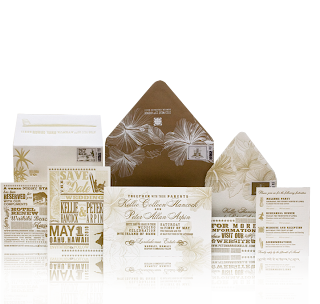By Patricia Canole
The good news: There’s a
wealth of invitation options out there. The bad news: There’s a wealth of
invitation options out there! With all of this variety, finding your perfect
invite can be overwhelming. To help, I’ve narrowed down the style types to
three basic categories—ready-made, DIY and custom/couture. Here’s the scoop to
decide what’s best for you.
WHAT’S YOUR STYLE?
 |
| Ceci New York |
Ready-made: Because ready-made invitations take the legwork out of
trying to come up with a design from scratch, they’re great for busy brides who
don’t have time to DIY and don’t have room in their budget to order couture
customized invites.
DIY: Do-it-yourself
invitations are for the bride who has a specific invitation theme in mind and
wants to create them herself. Most likely, she’ll use an online service to help
in designing and printing.
Custom/Couture: Truly customized invitations are for the style-minded
bride who is seeking fine craftsmanship and design, flawless execution and
one-of-a-kind creativity—the bride who doesn’t want what anyone else has.
PROS & CONS
 |
| Paperless Post |
Ready-made: A ready-made invitation means less work for a
bride—all she has to do is simply apply her wording to an already created
design. These invitations can also benefit budget-conscious couples. The
disadvantage is that most designs are copyrighted by the manufacturer, so the
customer usually can’t tweak the design or change its color.
DIY: The advantage of ordering DIY invitations is that you
get exactly what you’re looking for without having to pay for the pieces you
don’t need. Using an online service also saves you from having to print them
yourself: this may increase the cost but is a big time saver.
Custom/Couture: The advantage is that couples don’t have to spend time
deciding. Instead, they turn the process over to a designer who’s equipped to
create a work of art that completely suits them. On the downside, couture
invitations take longer than the other types and will cost more.
HOW DOES IT WORK?
Ready-made: These invites are created with sample text on a preset
design with preset colors and embellishments. A bride can borrow each
collection and personalize her chosen invitation with wording in the ink colors
of her choice.
 |
| Lilah Paper |
DIY: The couple uses a website to choose all of the
elements they want to include. The next step is picking the paper color,
imprint color, wording, font, printing process and design. The company will
print the invites and deliver them to the bride to address and send out on her
own.
Custom/Couture: The process usually starts with a creative
consultation where the bride defines her style, desires and needs. A designer
will know exactly what makes his or her clients excited and present
possibilities that make them say “yes.”
 Avoid foods with saturated fats such as chips and creamy dips. The oils in these foods are not only bad for your waistline but also for your skin. Instead, reach for the vegetable platter and healthier dips such as hummus or guacamole (the avocado in guacamole is delicious and has Vitamins A, D and E which makes the skin look vibrant).
Avoid foods with saturated fats such as chips and creamy dips. The oils in these foods are not only bad for your waistline but also for your skin. Instead, reach for the vegetable platter and healthier dips such as hummus or guacamole (the avocado in guacamole is delicious and has Vitamins A, D and E which makes the skin look vibrant).





